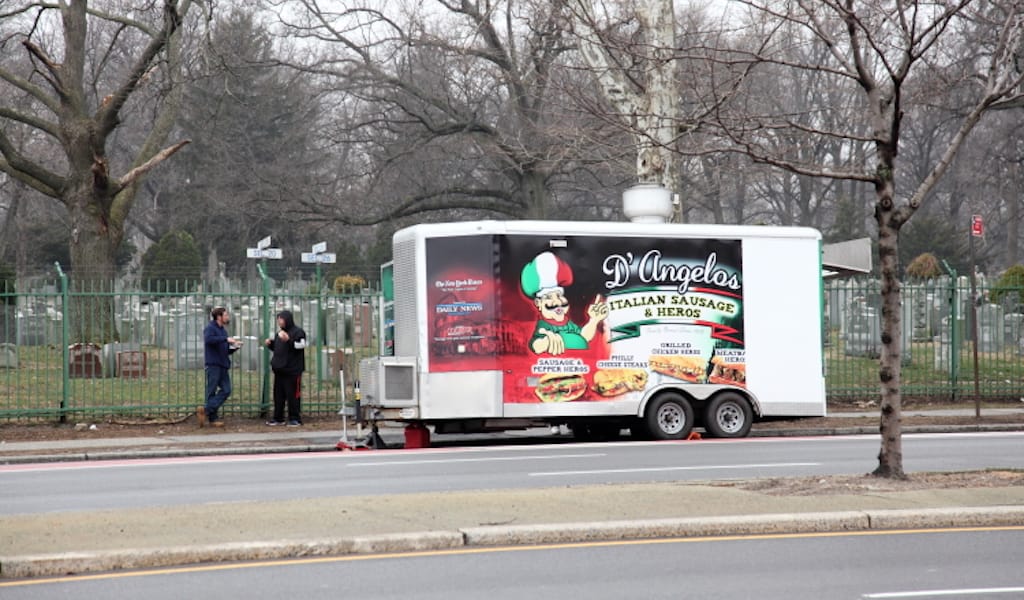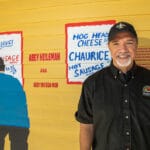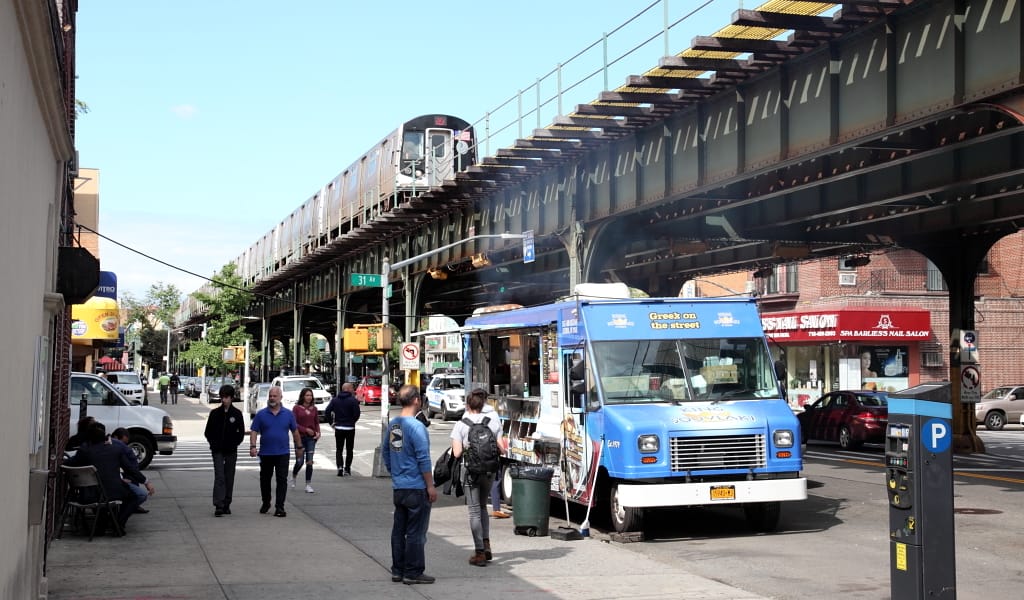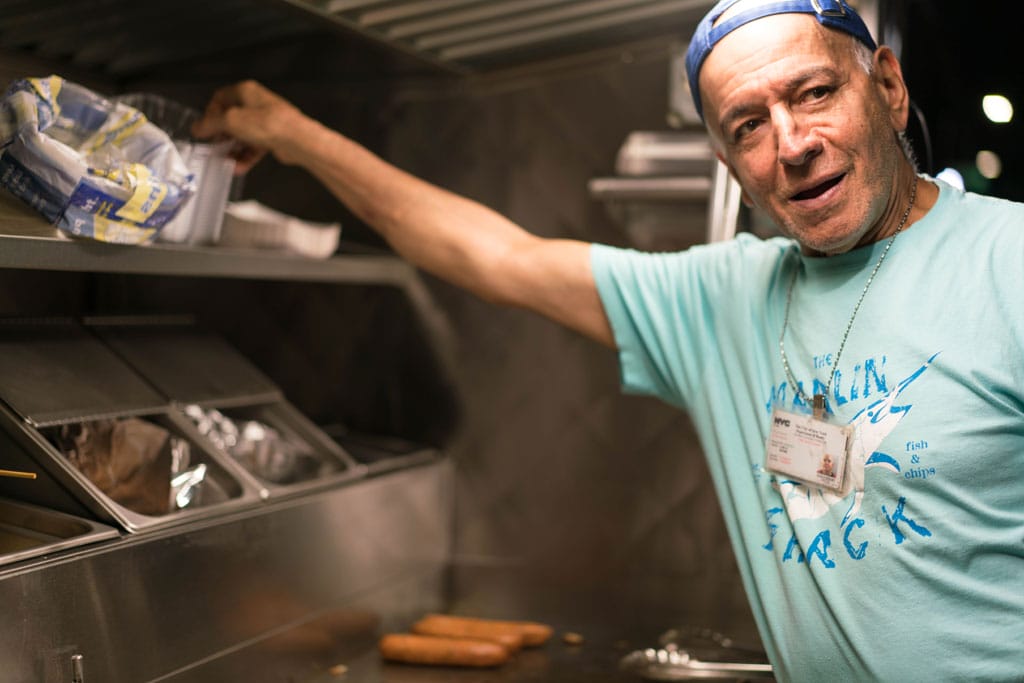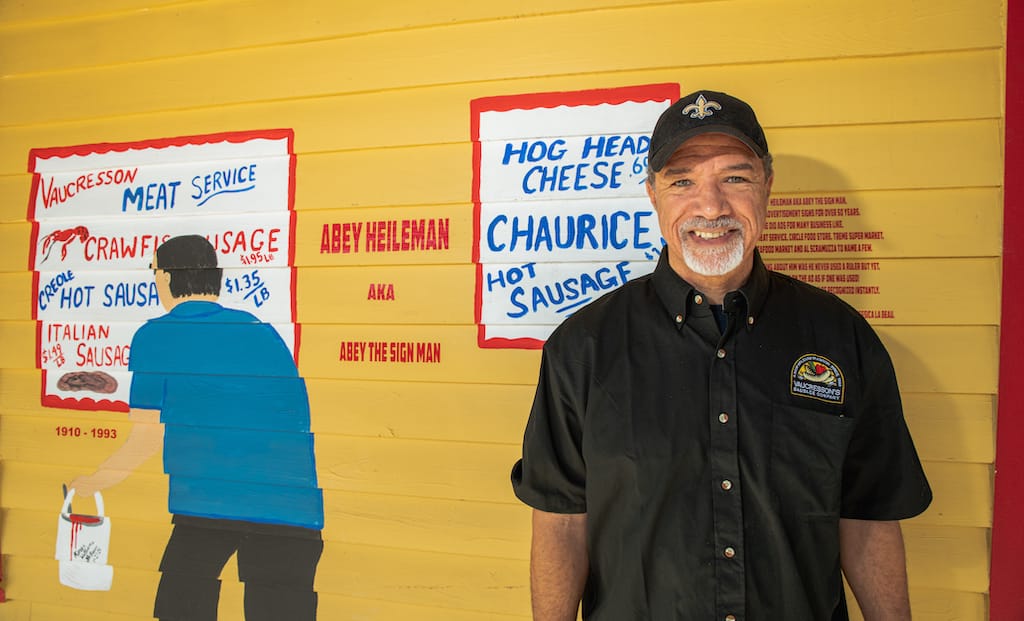New York’s street food vendors usually ply their trade where potential customers congregate. On side streets in midtown Manhattan, they set up four and five abreast for the weekday lunch rush. During warm-weather weekends, they feed footballers and their fans outside ball fields in the Brooklyn neighborhoods of Red Hook and East New York. In Queens, they do business beside a miles-long stretch of Roosevelt Avenue where it passes through Woodside, Jackson Heights, Elmhurst, and Corona; they cluster thickly near station stops of the elevated 7 train.
The setting of the D’Angelos Italian Sausage truck presents a dramatic contrast. Monday through Saturday, the truck parks in a long-established spot on Woodhaven Boulevard, on the border between two largely residential neighborhoods, Middle Village and Rego Park, beside the green expanse of St. John Cemetery.
The enclosed cemetery and the breadth of the boulevard – in each direction, four lanes of traffic plus one lane for parking – all but rule out a walk-up clientele. (We were the rare exception.) Most people drive to D’Angelos, which itself has become a reason for customers to gather.
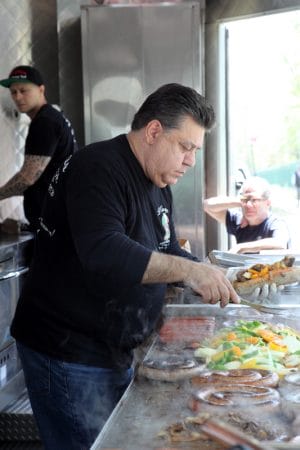 “Hey, buddy,” calls out Gary D’Angelo when we catch his eye. On our most recent visit he was working the grill with his nephew Anthony and Anthony’s brother-in-law, Tony, inside a truck that Gary’s grandfather, an immigrant from Naples, would scarcely have recognized. In the 1930s, at the annual Feast of San Gennaro, in Manhattan’s Little Italy, the original D’Angelos truck didn’t have a grill – Gary’s grandfather sold “Italian pastries, peanuts, chestnuts on a rope” and torrone, a nougat confection chopped to order from a “100-pound block.”
“Hey, buddy,” calls out Gary D’Angelo when we catch his eye. On our most recent visit he was working the grill with his nephew Anthony and Anthony’s brother-in-law, Tony, inside a truck that Gary’s grandfather, an immigrant from Naples, would scarcely have recognized. In the 1930s, at the annual Feast of San Gennaro, in Manhattan’s Little Italy, the original D’Angelos truck didn’t have a grill – Gary’s grandfather sold “Italian pastries, peanuts, chestnuts on a rope” and torrone, a nougat confection chopped to order from a “100-pound block.”
In later years the bill of fare changed to “seafood and sweetbreads” (yes, the variety meats, Gary confirms). Sausages become the mainstay of the business only after Gary’s father moved D’Angelos to its current location, in 1973 (a date commemorated on Anthony and Tony’s T-shirts). The original Queens truck, Gary remembers, was a ‘67 International Harvester; restored versions of this taller-than-wide, slant-nosed, split-windshield model have a lot of hipster cred. The current Queens “truck” is actually a trailer, which is pulled into place every day.
Tony also tells us of “guys who came here 30 years ago, when they were this high” – he extends his hand, palm down, at waist level – with their fathers. “Now they bring their kids and their dad.” Maybe the dad can’t walk too well these days, Tony adds, but he comes along for a sandwich; his son and the grandkids order at the truck and bring it back to their car, to eat as a family. D’Angelos, in this sense, is like a drive-in restaurant, a business model that today is uncommon even in New York’s suburbs and very rare within the city limits.
Customers who aren’t eating in their cars are often eating on their cars. We watch as three men uniformed in blue and one in plainclothes spread their lunch across the rear hood of a Chevy Impala, whose stubby antenna signals the presence of an unmarked police car. All sorts of other vehicles – contractors’ vans, a lawn-care pickup truck, an off-duty ambulance, staid sedans with city placards on the dash, and many private cars, too – come and go in a steady stream.
Customers who aren’t eating in their cars are often eating on their cars.
From the service window of the truck, Gary and his crew overlook the eastern edge of St. John Cemetery, a Roman Catholic burial ground and one of the largest cemeteries in the state. Italian heritage is common to many of the cemetery’s permanent residents, both famous (a governor, a mayor, a onetime candidate for vice president) and infamous (namesakes of three of the “five families” of the local Cosa Nostra, and a fistful of underbosses). Bodybuilder and fitness promoter Charles Atlas (birth name: Angelo Siciliano) lies at rest there, too.
Two generations removed from the original San Gennaro truck, however, D’Angelos is not purely Italian but, rather, Italian-American. Gary points out a recurring theme in the decoration – the Statue of Liberty flanked by the Colosseum of Rome – that proudly drives home this point. Likewise, it’s impossible to peg the customers to any narrow traditional demographic group. By and large they’re men, dressed in trim uniforms, or shirts and slacks, or company sweatshirts and blue jeans – working folks who know a good sandwich.
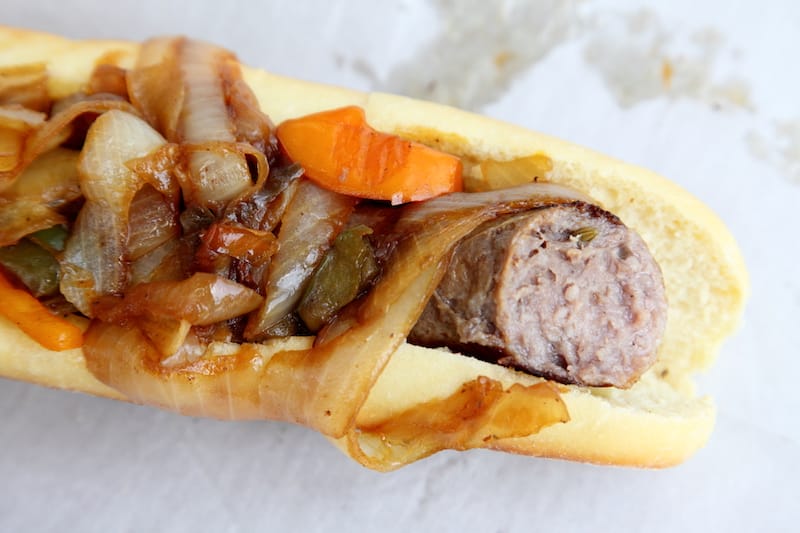
Time to eat. We can only imagine that the cheese steaks and chicken heroes have their fans; we’ve never tried them. The hot dogs are very good, singly or in pairs (but for these we favor Dominick’s Hot Dogs, the blue-and-silver truck parked just up the boulevard, where Angela D’Angelo serves them with a smile and a Yoo-Hoo). Today, only sausage will do.
The posted menu offers a choice of hot or sweet. We also overhear, for the first time, an order for “half-and-half” – two stubby sausages, one of each style, butted end-to-end. To us, half-and-half shows a lack of commitment. We decide on sweet sausage; ours is form-fitted to a superb semolina roll, smothered in grilled peppers and onions, handed over like a scepter to a king. We accept with both hands.
Other worthy customers await; we make room. “Nice seeing you, buddy,” Gary says to an older fellow who leans on a cane as he makes his way close. “Time goes on, right?”
Published on June 14, 2018
Related stories
September 4, 2017
QueensGrilling meat is a Greek tradition that hearkens back at least to the days of Homer. In his Iliad, the poet wrote of a sacrifice of cattle to the god Apollo, after which the men “cut all the remainder into pieces and spitted them and roasted all carefully.” They feasted, they drank wine, they sang…
July 8, 2016
Queens"Me siento latinoamericano de cualquier país, pero sin renunciar nunca a la nostalgia de mi tierra: Aracataca…” “I feel Latin American from any country, but without renouncing the nostalgia for my land: Aracataca…” ~Gabriel Garcia Marquez Most are animated, some waver and occasionally one stumbles. Every few feet, a door swings open and a bolero,…
May 13, 2024
New Orleans | By James Cullen
New OrleansThe blistering April – yes April – sun in New Orleans is an indicator of two things: climate change and the start of festival season. In other parts of the country, warm days and cool nights and the gradual bloom of trees and flowers define spring. But in Southeast Louisiana, spring seems to supernova into…







































